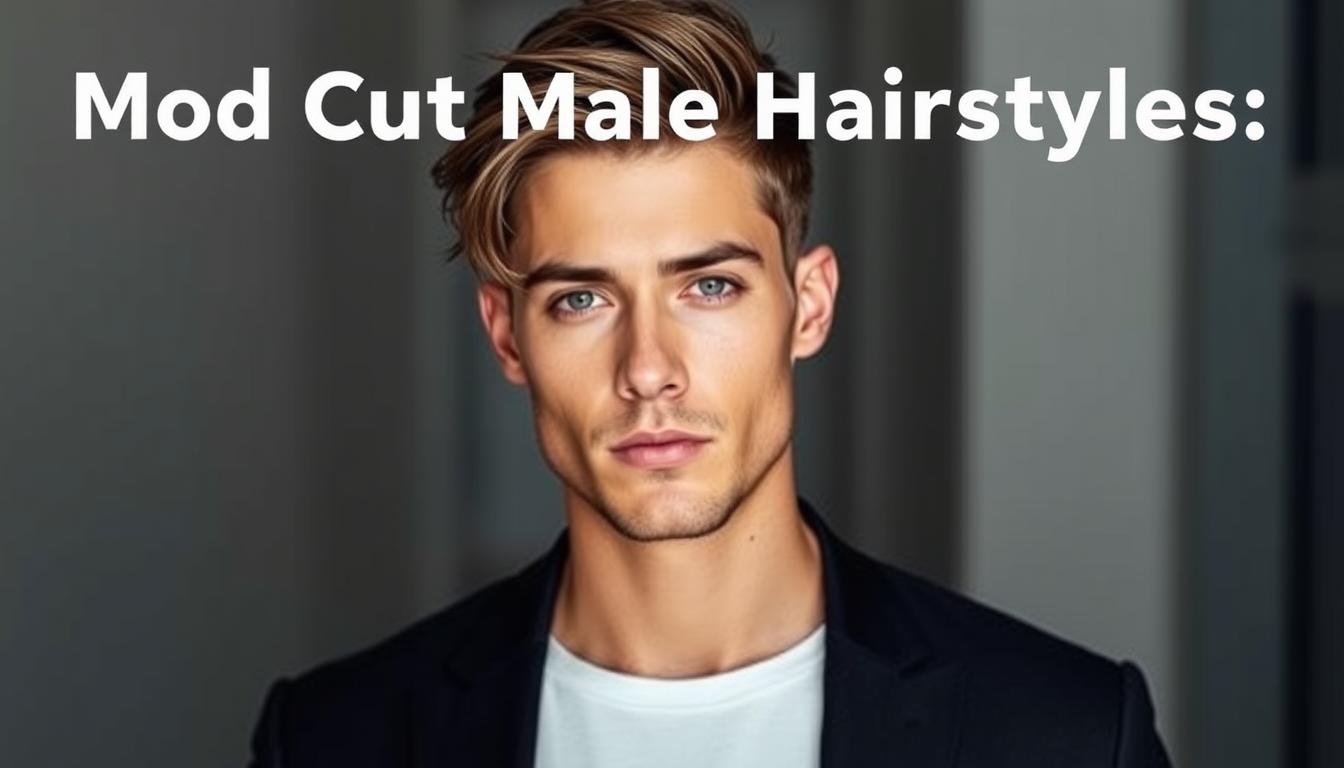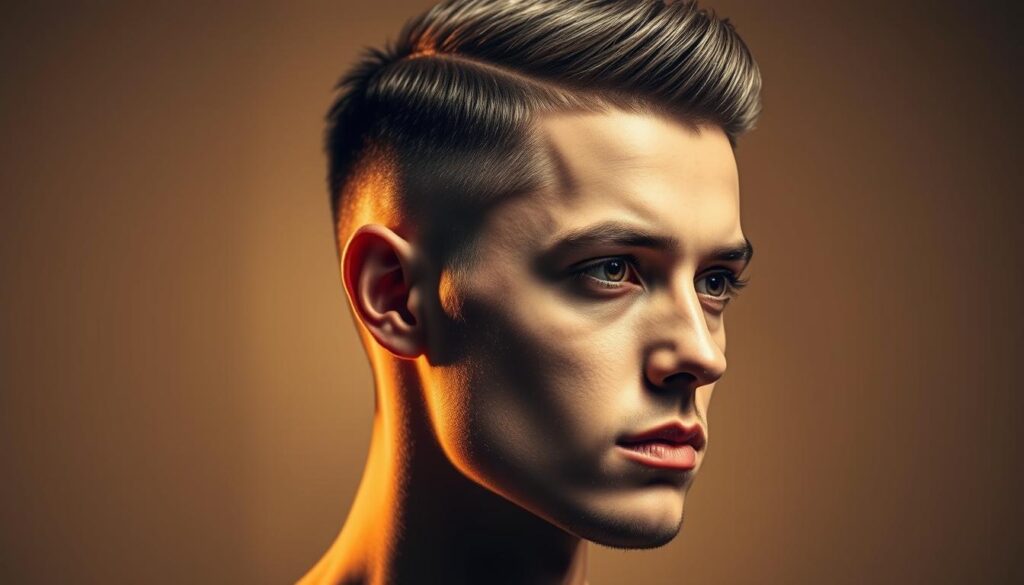
What if your next haircut could channel 1960s rebellion while feeling utterly contemporary? A style born from London’s jazz clubs and youth subcultures has resurged as today’s ultimate symbol of effortless cool. This look blends vintage edge with modern versatility, offering textures that range from casually tousled to sharply refined.
Originally popularized by rhythm-and-blues enthusiasts in the 60s, this iconic hairstyle has evolved into a staple for artists and trendsetters. Its textured layers create movement and depth, adapting seamlessly to both casual outfits and tailored looks. Celebrities like Jacob Elordi and Paul Mescal have embraced its rebellious sophistication, sparking renewed demand in barbershops nationwide.
What sets this style apart is its ability to reflect individuality. Whether you prefer a messy, lived-in finish or a polished structure, it serves as a canvas for personal expression. More than just a haircut, it’s a statement—one that balances cultural heritage with forward-thinking creativity.
Key Takeaways
- Discover how a 1960s subculture hairstyle became a modern fashion essential
- Learn why textured layers appeal to creative professionals and style rebels
- Explore options to customize your look from relaxed to refined
- See how celebrities are driving its popularity in today’s grooming trends
- Understand why this cut symbolizes confidence and individuality
What is the Mod Cut?

Imagine a hairstyle that captures London’s swinging 60s energy while fitting perfectly into today’s streetwear scene. This iconic look balances rebellion with precision—a signature of those who value both history and self-expression.
Historical Roots and Cultural Influence
Born in underground jazz clubs, this style became a badge of honor for 1960s Modernists. These trendsetters rejected conformity, pairing sharp suits with hairstyles that screamed individuality. Their textured looks mirrored the era’s musical revolution—think The Who’s raw energy meeting tailored sophistication.
Decades later, Britpop bands reignited the flame. Oasis’s Noel Gallagher made headlines not just for anthems like “Wonderwall,” but for his shaggy, fringe-forward take on the classic silhouette. This 90s revival proved the cut’s timeless adaptability.
Defining Characteristics of a Mod Cut
The magic lies in contrast. Longer, piece-y layers on top create height, while sides stay tapered for clean lines. A straight-across fringe frames the face, often grazing the eyebrows for that signature shadow effect.
Barbers use scissors—not clippers—to craft subtle graduation around the ears and neck. This technique maintains soft edges, letting the style grow out gracefully. The result? A lived-in texture that says “I woke up like this”… after expert styling.
Mod Cut Male: Styling Tips and Techniques

The secret to nailing this iconic style lies in balancing technique with the right products. Start with freshly washed strands—use a clarifying shampoo weekly to strip residue. Towel-dry until damp, never soaking wet.
Step-by-Step Styling Instructions
Rub a pea-sized amount of texturizing clay between palms. Work through mid-lengths to ends, avoiding roots initially. Blow-dry while lifting sections with a round brush—this builds root volume that lasts hours.
For wavy types, attach a diffuser and dry on low heat. Use a wide-tooth comb to separate strands once 80% dry. Finish by tousling with fingertips for that “just-left-the-beach” texture.
Using the Right Hair Products
Four key products dominate this look. Pomade slicks down stubborn fringes, while styling clay adds grit without crunch. Curly textures thrive with lightweight cream, and mousse gives fine hair lasting volume.
Lock everything in place with a clay-based spray at the crown. A final spritz of flexible hair spray keeps flyaways tame. Your style remains intact from morning coffee to last call.
Choosing the Right Mod Cut for Your Face Shape
Your hairstyle should enhance your natural features, not fight against them. This iconic look adapts beautifully to different facial structures through strategic adjustments in length and texture. The key lies in balancing proportions to highlight your strongest angles while creating visual harmony.
Tailoring the Look to Complement Your Features
Oval faces thrive with this style’s symmetry. The layered top and tapered sides mirror your balanced proportions, drawing attention to cheekbones without overwhelming delicate features. Ask your stylist to keep the fringe slightly longer for a soft frame around the eyes.
Square jawlines benefit from textured layers that soften angular edges. Let the crown area gain more volume to offset a strong chin. For rectangular faces, a blunt fringe sitting just above eyebrows shortens the appearance of length. Wider face types? Keep sides closely cropped and direct fringe sideways to create elongation.
Curly or wavy hair adds natural movement to the style. Work with your hair’s pattern rather than against it—looser curls pair well with longer layers, while tight coils shine in shorter, defined shapes. Always discuss maintenance needs with your barber to ensure daily styling stays manageable.
True versatility comes from customization. A skilled stylist can adjust graduation around your ears or modify fringe density to suit unique bone structure. Bring reference photos showing both front and profile views for precision tweaks that elevate your individual charm.
Essential Maintenance and Product Recommendations
Your hairstyle’s staying power depends on two factors: disciplined upkeep and strategic product use. Without them, even the most expertly crafted look loses its edge within weeks. Let’s explore how to sustain that fresh-from-the-barberchair appeal.
Maintenance Musts for a Fresh Look
Book appointments with your stylist every six weeks—eight max. Shorter lengths grow out unevenly, distorting the silhouette’s clean lines. A trusted barber will adjust graduation around your ears to keep proportions balanced as hair evolves.
Clarify strands weekly to strip stubborn waxes or gels. Follow with a moisturizing conditioner to maintain pliability. Blow-dry roots upward using medium heat to lock in volume that lasts all day.
Products to Enhance Texture and Volume
Not all styling aids work equally. Matte clay provides grip without shine—ideal for piece-y separation. Sea salt spray amplifies natural waves when misted onto damp hair before air-drying.
- Volumizing powder: Dust lightly at roots for instant lift
- Flexible-hold spray: Sets styles while allowing movement
- Scalp serum: Reduces dryness between washes
Apply products the right way: rub between palms first, then rake through mid-lengths. This technique goes a long way in preventing clumps or residue. Reading ingredient lists helps avoid silicones that dull texture over time.
How to Communicate Your Mod Cut Look with Your Barber
Your barber isn’t a mind reader—clear communication starts before you sit in the chair. One client’s “textured layers” might mean something entirely different to your stylist. This gap in understanding leads to 43% of haircut disappointments, according to recent grooming industry surveys.
Preparing Visual References and Discussion Points
Bring multiple photos showing front, side, and back angles. Search terms like “Britpop hairstyles” or “Ian Brown fringe” yield goldmine results. Thomas Meacock’s sharp graduation and Oasis-era textures show how this style adapts to different hair types.
Barbers prefer visual aids—they spark better conversations than vague requests. “Photos let us dissect what works about each look,” says LA stylist Marco Rivera. “Is it the fringe length? The taper ratio? These details matter.”
| Reference Style | Key Feature | Best For Hair Type |
|---|---|---|
| Classic 60s Mod | Blunt straight-across fringe | Straight/medium density |
| Oasis Revival | Messy curtain layers | Wavy/thick |
| Modern Texture | Disconnected side taper | Curly/fine |
| Ian Brown Variation | Asymmetric crown volume | All types |
Discuss these three elements before scissors touch your hair:
- How much daily styling you’ll realistically do
- Your hair’s natural growth patterns
- Specific features to avoid (e.g., too-short fringes)
Walk through each reference photo’s pros and cons. A good stylist will suggest adjustments for your face shape or hair texture. Never rush this conversation—it’s your style’s blueprint.
Exploring Variations of the Mod Cut
Not all retro styles age gracefully—some evolve. This iconic look has branched into fresh interpretations while keeping its rebellious DNA. Whether you crave vintage authenticity or contemporary flair, there’s a version that fits your vibe.
From Classic 60s to Modern Edge
The original 1960s version features cropped sides blending into a collar-length nape. Longer strands on top create a straight-across fringe hitting the brows. Modern twists include beachy waves cascading over the forehead or thick sideburns paired with stubble.
Textured options thrive today. Try choppy layers at the crown for messy volume or side-swept bangs that frame angular jaws. Curly types can embrace natural coils with tapered sides, while straight hair shines in sleek, piecey styles.
Understanding the Mod Cut Versus the Mullet
Though both nod to retro eras, their silhouettes differ sharply. See how they compare:
| Feature | Mod Cut | Mullet |
|---|---|---|
| Fringe | Full, straight-across | {{the}} or nonexistent |
| Sides | Tapered with pointed sideburns | Shaved or closely cropped |
| Back | Graduated nape | Dramatic length |
| Volume | Top-focused layers | Uniform throughout |
While mullets prioritize a “party in the back” aesthetic, this style balances structured sides with textured movement up top. It’s rebellion with refinement—no mullet-induced whiplash required.
Conclusion
True style transcends decades when rooted in self-assurance. This iconic hairstyle proves that confidence isn’t about following trends—it’s about owning a look that mirrors your personality. With its textured layers and tapered sides, it bridges eras effortlessly.
Whether you’re dressing up or keeping it casual, this versatile style adapts. Oval faces gain definition, while square jaws soften with strategic volume. Curly textures bounce with natural energy, and straight strands achieve sleek separation.
Maintenance stays simple with the right clay or spray. A quick tousle revives its shape, and six-week trims keep edges sharp. The magic lies in customization—your barber can tweak fringes or graduation to highlight your best features.
More than a retro nod, it’s a celebration of individuality. From London’s jazz clubs to today’s streets, this cut remains a badge of creative rebellion. Ready to embrace a look that’s authentically yours? Your chair awaits.
